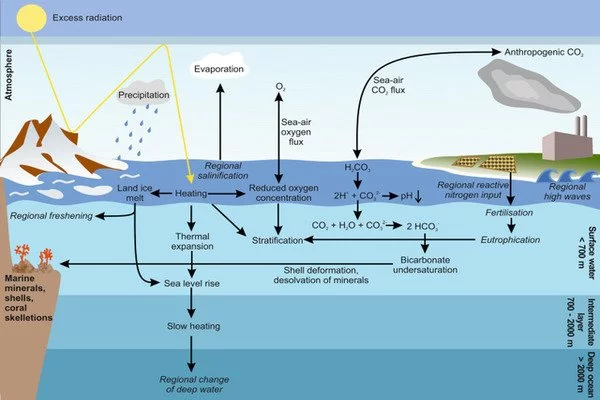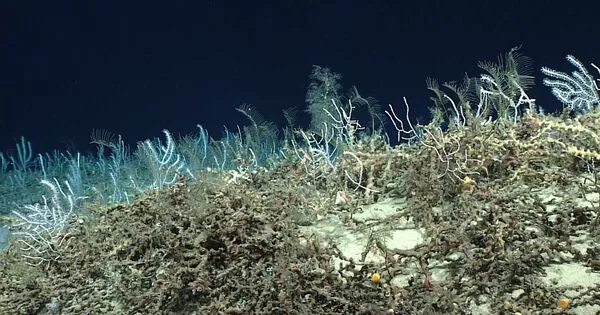Deep-sea coral research has revealed that ocean currents have not fueled the increase in atmospheric carbon dioxide (CO2). This finding contradicts a previously held hypothesis that deep-sea currents were responsible for massive CO2 emissions into the atmosphere.
A groundbreaking study of deep-sea corals has debunked the theory that ocean currents contributed to rising global levels of carbon dioxide in the atmosphere over the last 11,000 years. The research, led by the University of Bristol in the United Kingdom and Nanjing University in China, looked at historic deep-sea corals to shed new light on the history of ocean chemistry.
Understanding what caused the pre-industrial rise in carbon dioxide (CO2) levels during the Holocene period, which lasted 11,700 years and continues to this day, is a source of scientific debate. One theory suggests that changes in high-latitude ocean circulation, or the physical upwelling of carbon-rich deep waters to the surface of the Southern Ocean, may have triggered the release of marine carbon into the atmosphere, though this is not fully understood.
Lead author Tianyu Chen, Professor of Marine Geochemistry at Nanjing University and the University of Bristol, said: “Our research challenges assumptions about the role of ocean circulation in the carbon cycle during the Holocene. By providing radiocarbon evidence for the stability of these processes, we pave the way for a deeper understanding of the complex interactions between the ocean and the Earth’s climate system.”
Our research challenges assumptions about the role of ocean circulation in the carbon cycle during the Holocene. By providing radiocarbon evidence for the stability of these processes, we pave the way for a deeper understanding of the complex interactions between the ocean and the Earth’s climate system.
Tianyu Chen
The Holocene, which followed the retreat of major ice sheets in the Northern Hemisphere, is the most recent interglacial period on Earth and has long piqued the interest of scientists studying Earth’s recent climate history. The rise in atmospheric CO2 levels is a key feature of this time period. CO2 levels were initially around 260 parts per million by volume (ppmv) in the early Holocene. However, over the course of approximately 5,000 years, they increased by 20 ppmv, which is equivalent to approximately 150 gigatonnes of CO2.
Corals are remarkable organisms that have thrived on seamounts throughout the Holocene period. The international team of researchers meticulously dated deep sea coral data from the Drake Passage, which connects South America and Antarctica, as well as the Reykjanes Ridge, which is located south of Iceland, from this time period. These corals can be found in water depths of up to 1,900 metres in Antarctic circumpolar waters and the North Atlantic Deep Water.
Surprisingly, radiocarbon data indicated that ventilation in Antarctic circumpolar waters and the North Atlantic Deep Water remained relatively stable.

The findings, published today in Nature Geoscience, show that long-term polar ocean mixing between surface and deep water did not experience significant disturbances on a millennial scale. As a result, it appears that the North Atlantic and Southern Ocean circulation did not alone drive the rise in atmospheric CO2 levels during the Holocene. Instead, the researchers believe that biogeochemical cycles that redistribute nutrients and carbon in the ocean and on land may have contributed to the rise.
“Thanks to the decay of radioactive isotopes within their skeletons, deep-sea corals effectively contain two ‘clocks,'” said co-author Dr. Joseph Stewart, Research Fellow in Geochemistry at the University of Bristol. The corals contain trace amounts of uranium-238, which gradually decays to thorium-230, allowing us to accurately determine their age by measuring this isotope ratio.
“The second clock, radiocarbon (carbon-14) also slowly decays away, however, it predominantly enters the oceans via the atmosphere. The radiocarbon content of corals, therefore, tells us how long radiocarbon-depleted deep waters have been out of contact with radiocarbon-rich surface waters. By using both ‘clocks’ together we were able to assess the rates of ocean ventilation during this key interval.”
This study is an important step toward understanding the relationship between ocean circulation, carbon cycling, and Holocene climate dynamics. To fully comprehend the Holocene atmosphere’s carbon budget, a future comprehensive understanding of natural and human-induced variations in the carbon cycle will be required.
“These findings contribute to the growing body of knowledge in this field and underscore the importance of further exploring the mechanism that decouples the biogeochemical cycle and physical ocean circulation during the Holocene,” said co-author Laura Robinson, Professor of Geochemistry at the University of Bristol.





